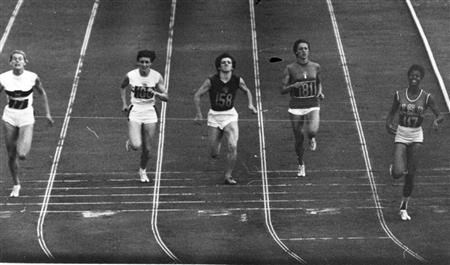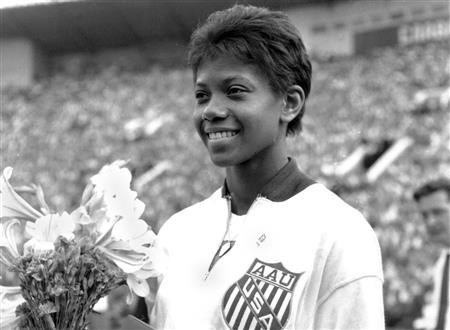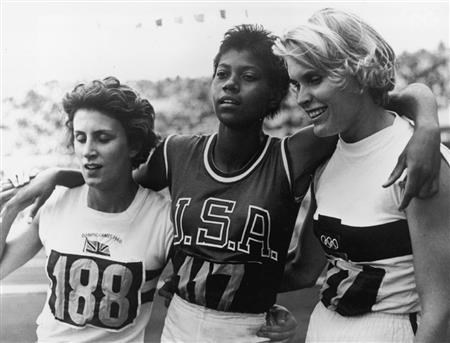 |
| (www.allposters.com ()) |
Wilma Rudolph was a great athlete who competed in the Olympic games. She worked hard to achieve her dreams by training hard. She began competing in track when she was young and eventually made it to the Olympics (Smith)."Wilma Rudolph made Olympic history in 1960 when she became the first American woman ever to win three gold medals in track and field events. Her achievement would have been remarkable for any athlete, but it was even more impressive because Rudolph had spent her childhood in leg braces and special shoes; doctors had told her family that she would never walk normally"("Wilma Rudolph."). Wilma Rudolph made a mark on the world when she won 3 gold medals in the Olympics in Australia at such a young age. She had the ambition to overcome the obstacles of her disability and achieve her goals. With the help of her physical therapist, family, and supporting friends, Wilma Rudolph was finally able to walk normally at age 12. She accomplished her goal of walking without a brace and had the urge to get back on her feet. She could finally play outside with the neighborhood kids without being "different"("Wilma Rudolph."). Wilma Rudolph is a hero because of her outstanding accomplishments. She worked for what she wanted to achieve like most heroes. She was a great role model for people in her era and is still a role model for athletes now. She displays courage, passion, and devotion towards her sport. Wilma Rudolph was a devoted hero who was brave throughout her life and also had the ambition to work for what she wanted.
 |
| Wilma Rudolph (www.wodumedia.com ()) |
Wilma Rudolph was a brave individual who overcame her challenges and disabilities by thinking positively. When she was born, Rudolph had a disability in her leg. She used many resources to help herself walk even though doctors argued that she would never be able to walk normally("Wilma Rudolph."). "When Rudolph was eleven, her family's persistence with her physical therapy, her long training without the brace, and her determination paid off: she took off the brace and was able to walk normally without it. She progressed rapidly from then on, and not only walked, but outran her peers"("Wilma Rudolph."). She was brave and overcame the obstacles in front of her. Rudolph was very excited about not having to wear a leg brace. She could finally joined sports teams and competed(Nadasen). Rudolph eventually joined track and field once she found her love for running. She competed at a high level with the help of her coach, Ed Temple. They worked together to make her a better athlete on and off the track. With Temple's help, Rudolph made her way to the Olympics(Nasaden). "Under Temple's coaching and through her hard work, Rudolph qualified at age sixteen to become the youngest member of the 1956 U.S. Olympic women's track and field team. At the Olympic Games in Melbourne, Australia, she lost in the 200-meter race but won a bronze medal as part of the 400-meter relay team. She dedicated herself to doing even better at the 1960 Olympics in Rome"(Berlage). Wilma Rudolph showed bravery throughout her entire life. When she was a baby, she had problems in her legs. As she grew up, she managed to walk without a brace. At age sixteen, Rudolph was brave enough to travel across the world to compete in the Olympics in Melbourne, Australia. She even traveled to Rome to compete. Wilma Rudolph was a brave athlete who risked all she had to travel the world. Leaving most of her family behind, she traveled around the world to achieve her goals("Rudolph, Wilma.").
Wilma Rudolph was very ambitious during the time of her Olympic career. She worked hard to become a better athlete and was disappointed in herself when she lost races. She only competed against other schools in track and field in high school. When she competed with upper division athletes, she was harsh on herself when she was anything but first place(Berlage). "By the time she was in high school Rudolph was winning every race she entered, yet she knew she needed expert training. At the end of her sophomore year she had been selected to compete against the top runners in the South at a track meet in Tuskegee, Alabama. She expected to win, but to her horror she lost every race, which caused her to conclude she needed intensive training to reach the competitive level she envisioned for herself"(Berlage). She worked hard to win races and was disappointed when she lost. At a race in Alabama, Rudolph lost every race. She felt like she could do better and started to train hard to make her way up to a competitive level(Berlage). After her disappointing loss in Alabama, Rudolph worked with her coach to shape her into a better athlete. "At age 16 she competed in the 1956 Olympic Games at Melbourne, Australia, winning a bronze medal in the 100-metre relay race. In 1960, before the Olympic Games at Rome, she set a world record of 22.9 seconds for the 200-metre race"("Wilma Rudolph | Biography - American Athlete."). She did work hard and traveled to Australia to compete in the Olympics. At this event, she won a bronze medal and set an outstanding world record for the 200-meter race("Wilma Rudolph | Biography - American Athlete."). She set world records and even made her way to compete in two Olympic Games. Wilma Rudolph had the ambition to become a better athlete and worked toward her goal.
 |
| (www.olympic.org ()) |
Wilma Rudolph was brave enough to stay strong even with her disability. She healed and became an ambitious athlete. With the support of her coach and mother, Rudolph trained hard for every sport she participated in. She enjoyed track and field which led her to success. She ran 20 miles each day for practice and strived to compete in the Olympics. She did make it to the Olympics and made her team proud. With three gold medals in her hands, Wilma left her mark in Australia. Four years later, she traveled to Rome to compete in her last Olympic Game(Smith). Wilma Rudolph is an inspiration because she ended on a good note with the Olympics. She retired and decided to dedicate her life to helping others. She became a teacher and devoted her time to help communities in need. Wilma also became a goodwill ambassador. Wilma Rudolph is also an inspiration because of all that she has accomplished. She was a kid who was told that she would never walk normally again. She proved her peers wrong when she finally was able to walk without a special brace for her leg. She had many achievements and worked hard to earn all of them. She helped teenagers become better athletes after she retired. She gave motivational speeches and is now remembered as a hero forever("Rudolph, Wilma."). Works Cited Berlage, Gai Ingham. "Wilma Rudolph." Scribner Encyclopedia of American Lives, Thematic Series: The 1960s. Ed. William L. O'Neill and Kenneth T. Jackson. New York: Charles Scribner's Sons, 2003.Biography in Context. Web. 31 Jan. 2015. Nadasen, Premilla. "Wilma Rudolph." Encyclopedia of African-American Culture and History. Gale, 2006.Biography in Context. Web. 31 Jan. 2015. "Rudolph, Wilma." UXL Encyclopedia of World Biography. Ed. Laura B. Tyle. Vol. 9. Detroit: UXL, 2003. 1646-1649. Gale Virtual Reference Library. Web. 2 Feb. 2015. Smith, Maureen Margaret. Wilma Rudolph: A Biography. Westport, CT: Greenwood, 2006. Print. "Wilma Rudolph | Biography - American Athlete." Encyclopedia Britannica Online. Encyclopedia Britannica, 29 July 2014. Web. 01 Feb. 2015. <http://www.britannica.com/EBchecked/topic/512271/Wilma-Rudolph>. "Wilma Rudolph." Notable Sports Figures. Ed. Dana R. Barnes. Detroit: Gale, 2004. Biography in Context. Web. 28 Jan. 2015.
Page created on 2/14/2015 12:00:00 AM
Last edited 2/14/2015 12:00:00 AM
